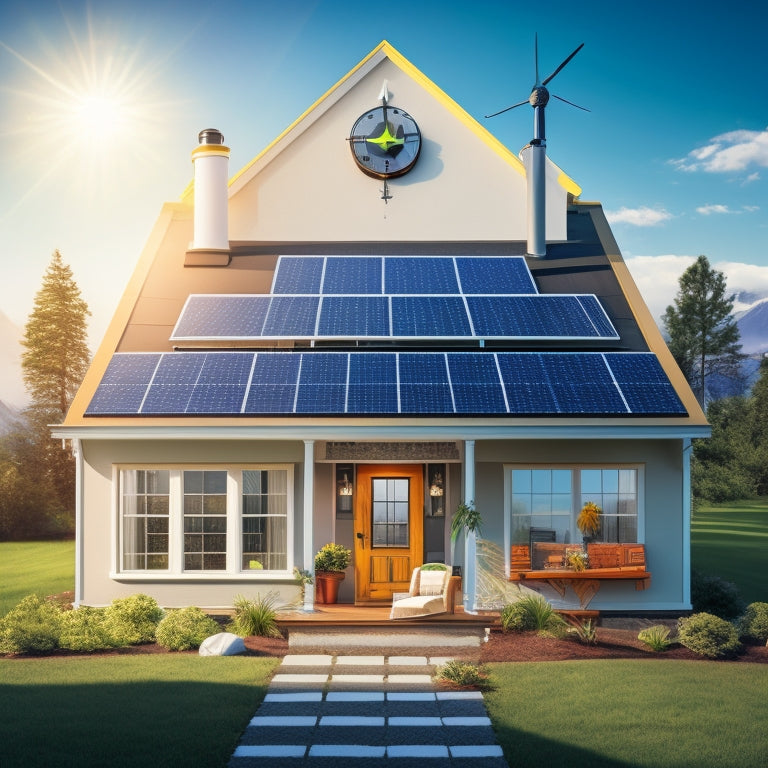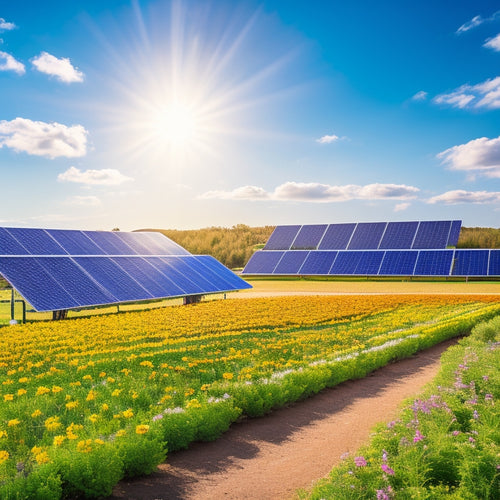
What Affects the Price of Solar Panels for Houses
Share
When considering solar panels for your house, you'll find that the price is influenced by several factors. The system's size and complexity, as well as the type and quality of panels, will impact costs. The installation company and labor rates, including their experience and equipment, also play a significant role. Your roof's size, condition, and angle will affect the installation process, and local incentives, rebates, and permits will influence the final cost. Energy efficiency, output, and mounting systems will also affect the price. As you maneuver through these factors, you'll get a better sense of what goes into the final cost of your solar panel system.
Key Takeaways
- System size and complexity, including roof conditions and energy requirements, impact the overall cost of solar panels for houses.
- The type and quality of solar panels, including efficiency and brand reputation, affect the price, with high-efficiency panels costing more.
- Installation company and labor costs vary depending on experience, reputation, and regional labor laws and regulations.
- Roof size and condition, including space requirements, optimal angle, and existing damage, influence the cost of solar panel installation.
- Local incentives, rebates, and discounts, such as state tax credits and utility company discounts, can significantly reduce the upfront cost of solar panels.
System Size and Complexity
When determining the price of solar panels for your house, system size and complexity play a significant role. The larger the system, the more expensive it will be. However, a larger system can also lead to greater system efficiency, as more panels can be connected to maximize energy production.
On the other hand, installation complexity also affects the price. If your roof is complex, with multiple angles, skylights, or obstructions, the installation process will be more challenging, leading to higher costs. The installation team may need to use specialized equipment or take extra precautions, adding to the overall expense.
To optimize system efficiency and minimize installation complexity, it's crucial to assess your roof's conditions and energy requirements. A professional solar panel installer can evaluate your property and design a system that meets your energy needs while minimizing costs.
Type and Quality of Panels
The type and quality of solar panels you choose greatly impact the overall cost of your solar panel system. High-efficiency panels, for instance, are more expensive than standard ones. However, they produce more power per hour of sunlight, making them a better option for homes with limited roof space.
When evaluating panel quality, consider the brand's reputation and warranty offered. Reputable brands like Tesla and SunPower provide high-quality panels with extended warranties, typically 25 years or more. These warranties often cover both the panel's performance and materials.
Panel efficiency also plays a significant role in determining the cost. More efficient panels convert a higher percentage of sunlight into electricity. While they're pricier upfront, they can save you money in the long run by generating more power.
Look for panels with high efficiency ratings, typically above 20%. Be prepared to pay a premium for top-tier panels, but know that they'll provide better performance and reliability over time.
Installation Company and Labor
You'll find that the installation company and labor costs account for a significant portion of your overall solar panel system expense. The installation company you choose will have a substantial impact on your total cost.
The company's installation experience and labor rates will influence the final price. Here are some key factors to take into account:
-
The installation company's reputation, certifications, and experience will affect labor rates. More experienced installers may charge higher rates.
-
The complexity of your roof and the installation process will also impact labor costs. Steep or irregularly-shaped roofs may require more labor hours.
-
The company's equipment and technology can also influence labor rates. Companies with more advanced equipment may be more efficient and charge lower rates.
- Local labor laws, permits, and regulations will also impact labor costs. Companies operating in areas with high labor costs or strict regulations may charge more.
When selecting an installation company, take these factors into account to guarantee you're getting the best value for your money.
Roof Size and Condition
When you're considering solar panels for your house, you'll need to assess your roof's size and condition to determine how many panels you can fit and where they'll go.
You'll want to confirm you have enough roof space available to accommodate the required number of panels, and that the roof's angle is suitable for peak energy production.
Additionally, you'll need to inspect your roof for existing damage, such as worn-out shingles or structural weaknesses, that could impact the installation process or panel performance.
Roof Space Availability
As you assess your home's suitability for solar panels, consider whether your roof has sufficient space to accommodate them. A roof with ample space can support more solar panels, leading to increased energy production and lower electricity bills.
When evaluating your roof's space availability, consider the following factors:
-
Solar orientation: Verify your roof receives sufficient sunlight throughout the day, ideally facing south or west.
-
Shading analysis: Identify potential obstructions, such as trees, chimneys, or neighboring buildings, that may cast shadows on your roof and reduce energy output.
-
Panel size and layout: Larger panels require more space, while smaller panels can be arranged to fit smaller roofs.
- Obstacles and features: Take into account vents, skylights, or other roof features that may limit the available space for solar panels.
Roof Angle Importance
Your roof's angle plays a vital role in determining the effectiveness of your solar panel system. The ideal roof angle for solar panels is between 30 and 40 degrees, as this allows for optimal energy production. If your roof is too shallow or too steep, it may not be suitable for solar panels.
Additionally, the orientation of your roof also affects energy production. A south-facing roof receives the most sunlight throughout the day, making it the most advantageous orientation. However, solar panels can still be installed on roofs with other orientations, albeit with slightly reduced energy production.
A thorough shading analysis is important to determine the impact of surrounding objects, such as trees or buildings, on your solar panel system's performance. Shading can greatly reduce energy production, so it's vital to assess the potential shading issues on your roof.
Existing Damage Impact
Before installing solar panels, it's essential to assess your roof's size and condition, as existing damage can greatly impact the system's performance and longevity.
You may think you're saving money by skipping this step, but neglecting an existing damage assessment can lead to costly repairs down the line.
Some common issues to look out for include:
- Cracked or missing shingles, which can allow water to seep in and cause further damage
- Sagging or uneven rooflines, which can affect the weight distribution of your solar panels
- Rusted or corroded flashing, which can lead to leaks and water damage
- Overgrown trees or debris, which can obstruct sunlight and reduce energy output
Failing to address these issues can result in additional repair costs, which will add to the overall price of your solar panel system.
Local Incentives and Rebates
You'll be pleased to know that local incentives and rebates can greatly reduce the upfront cost of solar panels for your house.
You may be eligible for state tax credits, which can offer a percentage of the total cost of your solar panel system as a credit against your state taxes.
Additionally, you can investigate utility company discounts, which provide a reduction in your electricity bill or a rebate on your solar panel installation.
State Tax Credits
In addition to federal incentives, many states offer their own tax credits and rebates to encourage homeowners to invest in solar energy. As you consider installing solar panels on your house, you should research the state-specific incentives available to you.
These incentives can greatly reduce the upfront cost of solar panel installation, making it more affordable for you.
Some states offer tax credits, which directly reduce your tax liability, while others provide rebates, which are basically refunds on your solar panel purchase. You may also be eligible for property tax exemptions or sales tax exemptions, which can further reduce your costs.
Here are some examples of state tax credits and rebates:
- California offers a rebate of up to $1.25 per watt for residential solar installations
- New York provides a tax credit of up to $5,000 for solar panel installations
- Arizona offers a tax credit of up to 25% of the total cost of a solar panel system
- Massachusetts provides a rebate of up to $2.50 per watt for residential solar installations
Keep in mind that state tax credits and rebates can vary widely, and their availability may be influenced by federal policies and market demand.
Be sure to investigate the specific incentives available in your state to maximize your savings.
Utility Company Discounts
Investigate your utility company's discounts and local incentives, which can further reduce the cost of going solar. Many utility companies offer special rates or discounts for homeowners who generate their own renewable energy. These utility incentives can be a significant factor in the overall cost of your solar panel system.
Check with your utility provider to see if they offer any of the following:
- time-of-use (TOU) rates, which charge you less for electricity consumed during off-peak hours;
- net metering, which credits you for excess energy produced;
- or special solar rates, which offer lower rates for solar-powered homes.
These incentives can help you save money on your electricity bill and offset the initial cost of your solar panel system.
Additionally, some utility companies offer energy credits, which can be sold back to the grid and used to offset your energy consumption. These credits can be traded or sold, providing an additional revenue stream for your solar-powered home.
Energy Efficiency and Output
Twenty years ago, solar panels were only about 12% efficient, meaning a considerable amount of sunlight was wasted as heat.
Fast forward to today, and you'll find that solar technology advancements have notably improved energy efficiency. You can now expect solar panels to have an average efficiency of around 20-22%. This increase in efficiency means you'll get more power per hour of sunlight, reducing the number of panels needed to meet your energy demands.
When it comes to energy output, several factors come into play. These include:
- The type and quality of solar panels used
- The amount of sunlight your location receives
- The angle and orientation of your solar panel installation
- The presence of energy storage solutions, such as batteries, to store excess energy generated during the day
With higher-efficiency solar panels, you'll be able to generate more power and reduce your reliance on the grid.
This can lead to substantial savings on your energy bills and a faster return on your investment.
Mounting and Tracking Systems
How do you guarantee your solar panels are positioned to maximize energy output? The answer lies in the mounting and tracking systems you choose.
Mounting options range from fixed-tilt systems, which are the most common, to adjustable-tilt systems that allow for seasonal adjustments. You can also opt for tracking systems, which actively adjust the panel's angle to follow the sun's movement.
The tracking benefits are substantial, with up to 45% more energy output compared to fixed-tilt systems. However, this increased energy production comes at a cost, as tracking systems are generally more expensive.
When considering mounting and tracking systems, it's crucial to weigh the costs against the benefits. For instance, if you live in an area with high energy prices, the increased output from a tracking system might justify the additional expense.
On the other hand, if you're in an area with lower energy prices, a fixed-tilt system might be a more cost-effective option.
Permits and Inspection Fees
As you've optimized your solar panel's performance with the right mounting and tracking system, it's time to tackle the administrative tasks that come with installing a solar panel system for your house.
One of the essential steps is obtaining the necessary permits and paying the associated fees. These costs can vary depending on your location and the type of permits required.
You'll need to comply with local zoning regulations and obtain permits from your local government. Some jurisdictions may require additional permits or have specific inspection requirements.
Here are some of the permits and fees you may need to take into account:
- Building permit: This permit guarantees that your solar panel system meets local building codes and safety standards.
- Electrical permit: This permit is required for the electrical connections and wiring associated with your solar panel system.
- Zoning permit: This permit confirms that your solar panel system complies with local zoning regulations, such as setbacks and height restrictions.
- Inspection fees: These fees cover the cost of having a certified inspector verify that your solar panel system meets local building codes and safety standards.
Remember to factor these permits and fees into your overall budget to guarantee a smooth and compliant installation process.
Frequently Asked Questions
Can I Install Solar Panels on a Rented House or Apartment?
You'll need to review your rental agreements and tenant rights before installing solar panels on a rented house or apartment, as some agreements may prohibit modifications or have specific regulations regarding renewable energy installations.
Do Solar Panels Work Well in Areas With Frequent Power Outages?
You'll find solar panels still generate power during frequent outages, as they're designed to provide electricity independently; however, their efficiency may vary depending on the outage duration, and you may want to contemplate backup power outage solutions for peak performance.
Are Solar Panels Damaged by Heavy Snowfall or Hail?
You'll be relieved to know that solar panels are designed to withstand harsh weather conditions. They're built with hail resistance in mind, and heavy snowfall's snow impact is minimized by the panel's angle and surface texture, ensuring ideal energy production.
Can I Finance My Solar Panel System Through a Home Equity Loan?
You can finance your solar panel system through a home equity loan, leveraging your property's value to access loan benefits, competitive interest rates, and flexible repayment options, while also enjoying tax incentives that reduce your overall solar financing costs.
Will Solar Panels Increase My Property Taxes?
You'll likely see a property value increase with solar panels, but you won't necessarily pay higher property taxes; many states exempt the added value from property tax implications, allowing you to reap solar energy benefits without the extra cost.
Conclusion
As you stand on the rooftop, gazing at the solar panels soaking up the sun's rays, remember that the price tag was shaped by a constellation of factors. The system's size and complexity, panel quality, installation labor, roof conditions, local incentives, energy output, mounting systems, and permits all played a role in determining the final cost. Like the threads of a fabric, each element intertwined to create a unique price point, reflecting the intricate dance between technology, environment, and economics.
Related Posts
-

Solar System Installation Rebates and Tax Credits
Solar system installations offer beneficial rebates and tax credits that greatly cut your initial costs. You can bene...
-

How Solar Panels Increase Property Value
Installing solar panels considerably increases your property value by improving energy efficiency and attracting eco-...
-

High-Performance Solar Solutions for Sustainable Living
High-performance solar solutions are your gateway to sustainable living, maximizing energy efficiency while considera...


